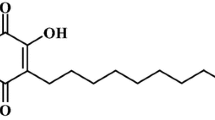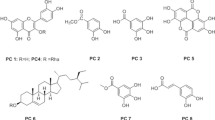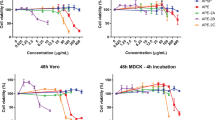Abstract
Influenza virus infection is a public health problem, causing significant morbidity and mortality. Currently, zanamivir and oseltamivir are in common use, and there are already reports of antiviral resistance. Several studies have shown the antiviral potential of a wide variety of plant-based natural compounds, among them those of the quinone type. In this study, we evaluated the antiviral activity of naphthoquinones isolated from the stem bark of Diospyros anisandra, and we selected zeylanone epoxide (ZEP) to study its effects on influenza A and B viruses. Our results indicated that ZEP inhibits the replication of influenza A and B viruses, at early and middle stages of the replication cycle. Confined nuclear localization of the viral NP indicated that ZEP affects its intracellular distribution and reduces viral yield. This is the first report on the antiviral properties and possible mechanism of action of ZEP in vitro, showing its broad-spectrum activity against influenza A and B viruses.






Similar content being viewed by others
References
Aoki-Utsubo C, Chen M, Hotta H (2018) Time-of-addition and temperature-shift assays to determine particular step(s) in the viral life cycle that is blocked by antiviral substance(s). Bio-protocol 8(9):e2830
Bodian D, Yamasaki B, Buswell R, Stearns J, White J, Kuntz D (1993) Inhibition of the fusion-inducing conformational change of influenza hemagglutinin by benzoquinones and hydroquinones. Biochem 32:2976–2978
Borges R, Uc A, Quintal C, Canché G, Cáceres M (2013) A selective chemical method for the separation of quinones from the stem bark of Diospyros anisandra. Int J Curr Pharm Res 5:13–17
Bouvier N, Palese P (2008) The biology of influenza virus. Vaccine 12:49–53
Burnham A, Baranovich T, Govorkova E (2013) Neuraminidase inhibitors for influenza B virus infection: Efficacy and resistance. Antiviral Res 100:520–534
CDC (2017) Types of influenza viruses. https://www.cdc.gov/flu/about/viruses/types.htm
Cianci C, Gerritz S, Deminie C, Krystal M (2013) Influenza nucleoprotein: promising target for antiviral chemotherapy. Antivir Chem Chemother 23:77–91
Chang S, Park J, Kim Y, Kang J, Min J (2016) A natural component from Euphorbia humifusa Willd displays novel, broad-spectrum anti-influenza activity by blocking nuclear export of viral ribonucleoprotein. Biochem Biophys Res Commun 471:282–289
Chaimayo C, Hayashi T, Underwood A, Hodges E, Takimoto T (2017) Selective incorporation of vRNP into influenza A virions determined by its specific interaction with M1 protein. Virology 505:23–32
Chavan R, Shinde B, Girkar K, Mandage R, Chowdhary A (2014) Identification of potent natural inhibitors against H1N1/A/2009 virus using in silico subtractive genomics approach and docking technology. Int J Pharm Res 6:105–113
Dayem AA, Choi HY, Kim YB, Cho S-G (2015) Antiviral effect of methylated flavonol isorhamnetin against influenza. PLoS One 10(3):e0121610
Dou D, Revol R, Östbye H, Wang H, Daniels R (2018) Influenza A virus cell entry, replication, virion assembly and movement. Front Immunol 9:1581–1597
Furuta Y, Takahashi K, Sangawa H, Kuno-Maekawa M, Uehara S, Nomura N, Kozaki K, Egawa H, Shiraki K (2005) Mechanism of Action of T-705 against influenza virus. Antimicrob Agents Chemother 49:981–986
Hook I, Mills C, Sheridan H (2014) Bioactive naphthoquinones from higher plants. In: Rahman A (ed) Studies in natural products chemistry. Elsevier, New York, pp 119–160
Hu Y, Sneyd H, Dekant R, Wang J (2017) Influenza A virus nucleoprotein: a highly conserved multifunctional viral protein as a hot antiviral drug target. Curr Top Med Chem 17:2271–2285
Hu Y, Zhang J, Musharrafieh R, Ma C, Hau R, Wang J (2017) Discovery of dapivirine, a nonnucleoside HIV-1 reverse transcriptase inhibitor, as a broad-spectrum antiviral against both influenza A and B viruses. Antiviral Res 145:103–113
Huang F, Chen J, Zhang J, Tan L, Lu G, Luo Y, Pan T, Liang J, Li Q, Luo B, Zhang H, Lu G (2018) Identification of a novel compound targeting the nuclear export of influenza A virus nucleoprotein. J Cell Mol Med 22:1826–1839
Klots L, Hou X, Jacob C (2014) 1,4-Naphthoquinones: from oxidative damage to cellular and inter-cellular signaling. Molecules 19:14902–14918
Kumagai Y, Shinkai Y, Miura T, Cho A (2012) The chemical biology of naphthoquinones and its environmental implications. Annu Rev Pharmacol Toxicol 52:221–247
Kwon H, Kim H, Yoon S, Ryu Y, Chang J, Cho K, Rho M, Park S, Lee W (2010) In vitro inhibitory activity of Alpinia katsumadai extracts against influenza virus infection and hemagglutination. Virol J 7:307–316
Li T, Chan M, Lee N (2015) Clinical implications of antiviral resistance in influenza. Viruses 7:4929–4944
Liu G, Xion S, Xiang Y, Gou C, Ge F, Yang C, Zhang Y, Wang Y, Kitazato K (2011) Antiviral activity and possible mechanisms of action of pentagalloylglucose (PGG) against influenza A virus. Arch Virol 156:1359–1369
Loregian A, Mercorelli B, Nannetti G, Compagnin C, Palù G (2014) Antiviral strategies against influenza virus: towards new therapeutic approaches. Cell Mol Life Sci 71:3659–3683
Makau J, Watanabe K, Kobayashi N (2013) Anti-influenza activity of Alchemilla mollis extract: possible virucidal activity against influenza virus particles. Drug Discov Ther 7:189–195
McKimm-Breschkin J (2013) Influenza neuraminidase inhibitors: antiviral action and mechanisms of resistance. Influenza Other Respir Viruses 7:25–36
Nematollahi A, Aminimoghadamfarouj N, Wiart C (2012) Reviews on 1,4-naphthoquinones from Diospyros L. J Asian Nat Prod Res 14:80–88
Newman D, Cragg G (2012) Natural products as sources of new drugs over the 30 years from 1981 to 2010. J Nat Prod 75:311–335
Perwitasari O, Johnson S, Yan X, Howerth E, Shacham S, Landesman Y, Baloglu E, McCauley D, Tamir S, Tompkins M, Tripp R (2014) Verdinexor, a novel selective inhibitor of nuclear export, reduces influenza A virus replication in vitro and in vivo. J Virol 88:10228–10243
Portela A, Digard P (2002) The influenza virus nucleoprotein: a multifunctional RNA-binding protein pivotal to virus replication. J Gen Virol 83:723–734
Rodriguez C, Shinyashiki M, Froines J, Yu R, Fukuto J, Cho A (2004) An examination of quinone toxicity using the yeast Saccharomyces cerevisiae model system. Toxicology 201:185–196
Song J, Lee K, Seong B (2005) Antiviral effect of catechins in green tea on influenza virus. Antiviral Res 68:66–74
Sydiskis R, Owen D, Lohr J, Rosler K, Blomster R (1991) Inactivation of enveloped viruses by anthraquinones extracted from plants. Antimicrob Agents Chemother 35:2463–2466
Szewczyk B, Bienkowska-Szewczyk K, Król E (2014) Introduction to molecular biology of influenza A viruses. Acta Biochim Pol 61:397–401
Uc A, Borges R, Said S, Vargas J, González F, Méndez M, Cáceres M, Molina G (2014) Naphthoquinones isolated from Diospyros anisandra exhibit potent activity against pan-resistant first-line drugs Mycobacterium tuberculosis strains. Pulm Pharmacol Ther 27:114–120
Uc A, Molina GM, Said S, Méndez M, Cáceres M, Borges R (2013) A new dimeric naphthoquinone from Diospyros anisandra. Nat Prod Res 27:1174–1178
WHO (2011) Manual for the laboratory diagnosis and virological surveillance of influenza. http://apps.who.int/iris/bitstream/10665/44518/1/9789241548090_eng.pdf
Yang Y, Zhao D, Yuan K, Zhou G, Wang Y, Xiao Y, Wang C, Xu J, Yang W (2014) Two new dimeric naphthoquinones with neuraminidase inhibitory activity from Lithospermum erythrorhizon. Nat Prod Res 29:908–913
Yang Z, Yang Y, Wu F, Feng X (2013) Computational investigation of interaction mechanisms between juglone and influenza virus surface glycoproteins. Mol Simul 39:788–795
Acknowledgments
This work was supported by CONACYT (project number 126763). Cetina-Montejo also acknowledges CONACYT for grant number 394861. We would like to thank technician M. Cáceres-Farfán for providing technical support in the GC-MS.
Author information
Authors and Affiliations
Corresponding authors
Ethics declarations
Conflict of interest
The authors declare that they have not conflict of interest.
Additional information
Handling Editor: Diego G. Diel.
Publisher's Note
Springer Nature remains neutral with regard to jurisdictional claims in published maps and institutional affiliations.
Electronic supplementary material
Below is the link to the electronic supplementary material.
Rights and permissions
About this article
Cite this article
Cetina-Montejo, L., Ayora-Talavera, G. & Borges-Argáez, R. Zeylanone epoxide isolated from Diospyros anisandra stem bark inhibits influenza virus in vitro. Arch Virol 164, 1543–1552 (2019). https://doi.org/10.1007/s00705-019-04223-y
Received:
Accepted:
Published:
Issue Date:
DOI: https://doi.org/10.1007/s00705-019-04223-y




